Project from
"Harm reduction and social care for drug users in East Asian
countries: A comprehensive comparative study" (in Japanese)

Project from
"Harm reduction and social care for drug users in East Asian
countries: A comprehensive comparative study" (in Japanese)

池田光穂(Mitsuho IKEDA)and 徐淑子(Sookja SUH)
 |
On Japanization
process of introduction to harm reduction policy: From 1970s to Present Mitsuho IKEDA, Osaka University, rosaldo+@+cscd.osaka-u.ac.jp Sookja SUH, Niigata College of Nursing The 45th Annual Meeting of the JSHMS, May 19, 2019 |
 |
"Harm reduction is
a set of practical strategies and ideas aimed at reducing negative
consequences associated with drug use. Harm Reduction is also a
movement for social justice built on a belief in, and respect for, the
rights of people who use drugs." - from the Harm Reduction Coalition - https://harmreduction.org/about-us/principles-of-harm-reduction/ |
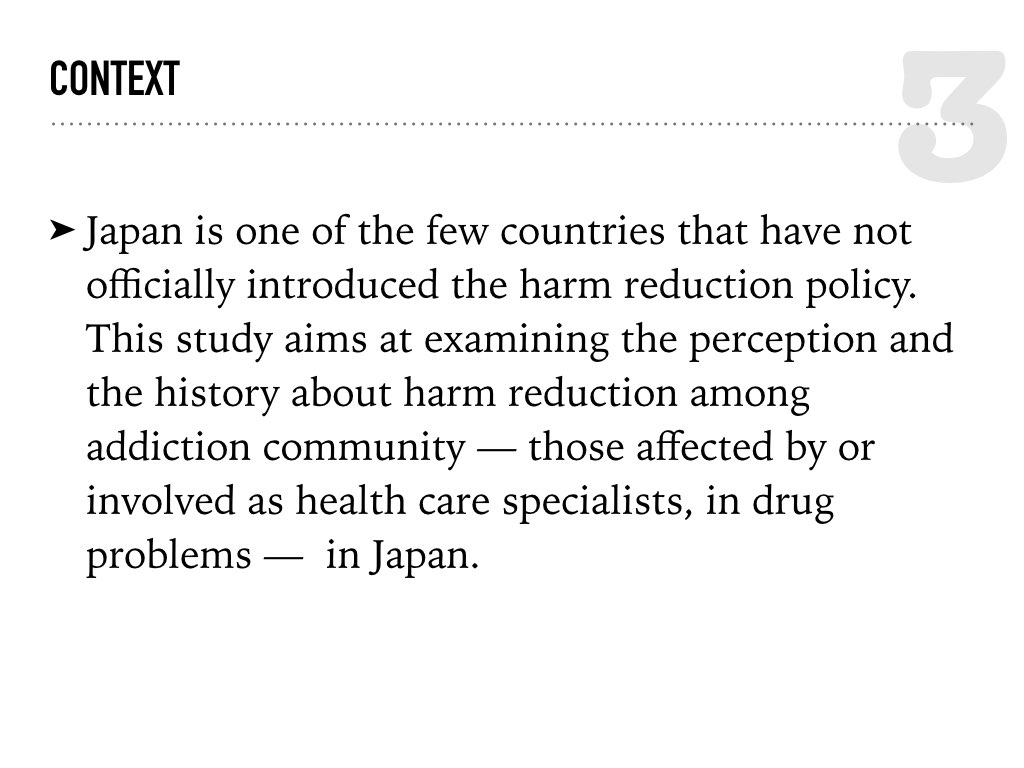 |
Context -> Japan is one of the few countries that have not officially introduced the harm reduction policy. This study aims at examining the perception and the history about harm reduction among addiction community — those affected by or involved as health care specialists, in drug problems — in Japan. |
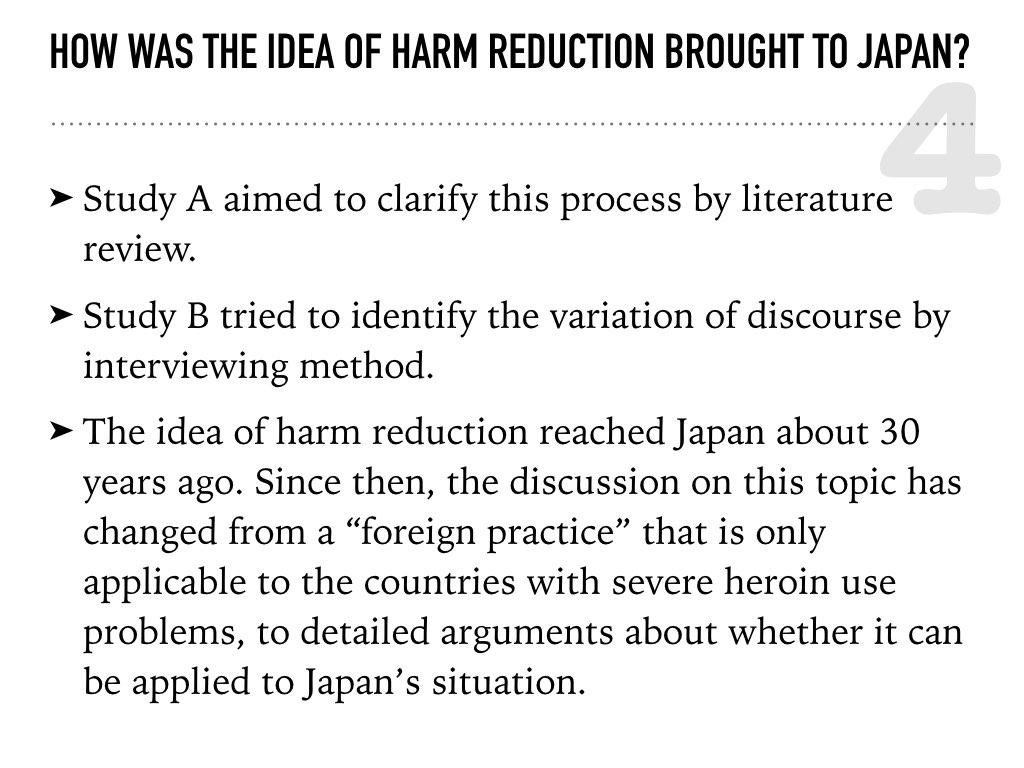 |
How was the idea
of harm reduction brought to Japan? ->Study A aimed to clarify this process by literature review. ->Study B tried to identify the variation of discourse by interviewing method. ->The idea of harm reduction reached Japan about 30 years ago. Since then, the discussion on this topic has changed from a “foreign practice” that is only applicable to the countries with severe heroin use problems, to detailed arguments about whether it can be applied to Japan’s situation. |
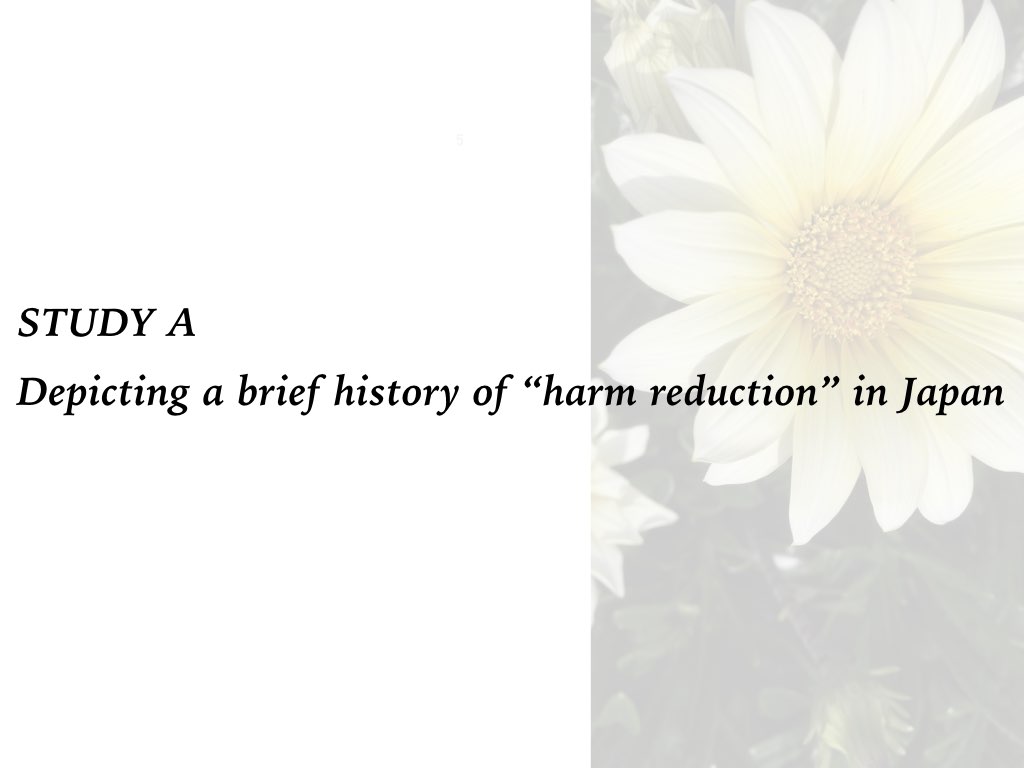 |
STUDY A Depicting a brief history of “harm reduction” in Japan |
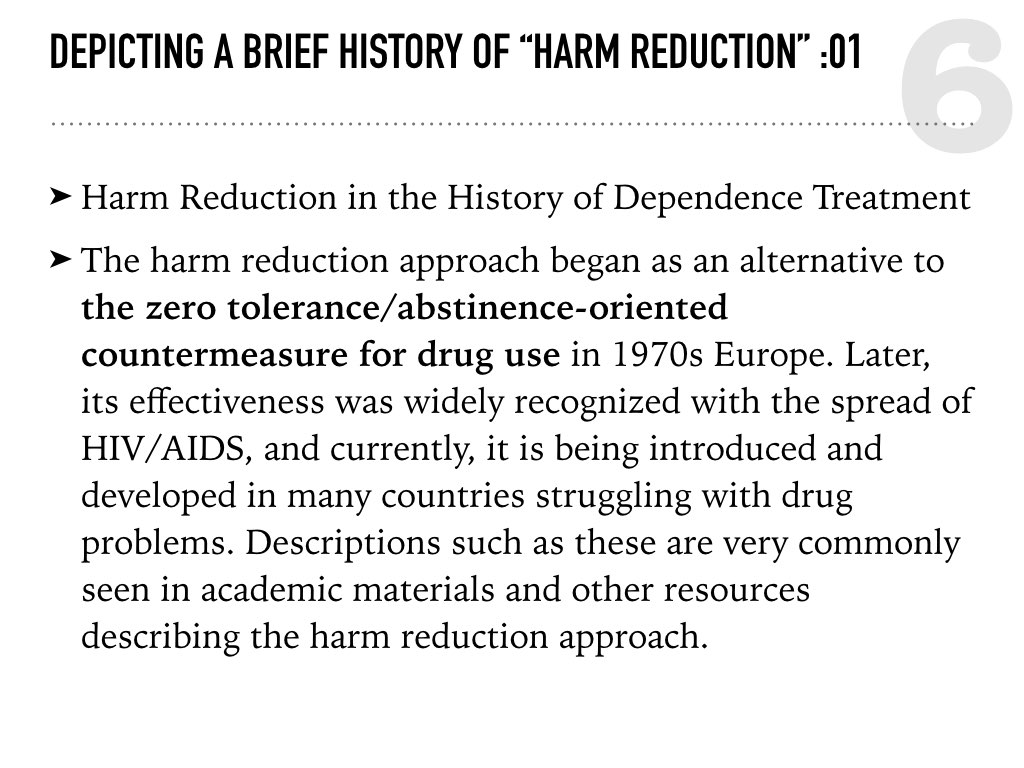 |
Depicting a brief
history of “harm reduction” :01 ->Harm Reduction in the History of Dependence Treatment ->The harm reduction approach began as an alternative to the zero tolerance/abstinence-oriented countermeasure for drug use in 1970s Europe. Later, its effectiveness was widely recognized with the spread of HIV/AIDS, and currently, it is being introduced and developed in many countries struggling with drug problems. Descriptions such as these are very commonly seen in academic materials and other resources describing the harm reduction approach. |
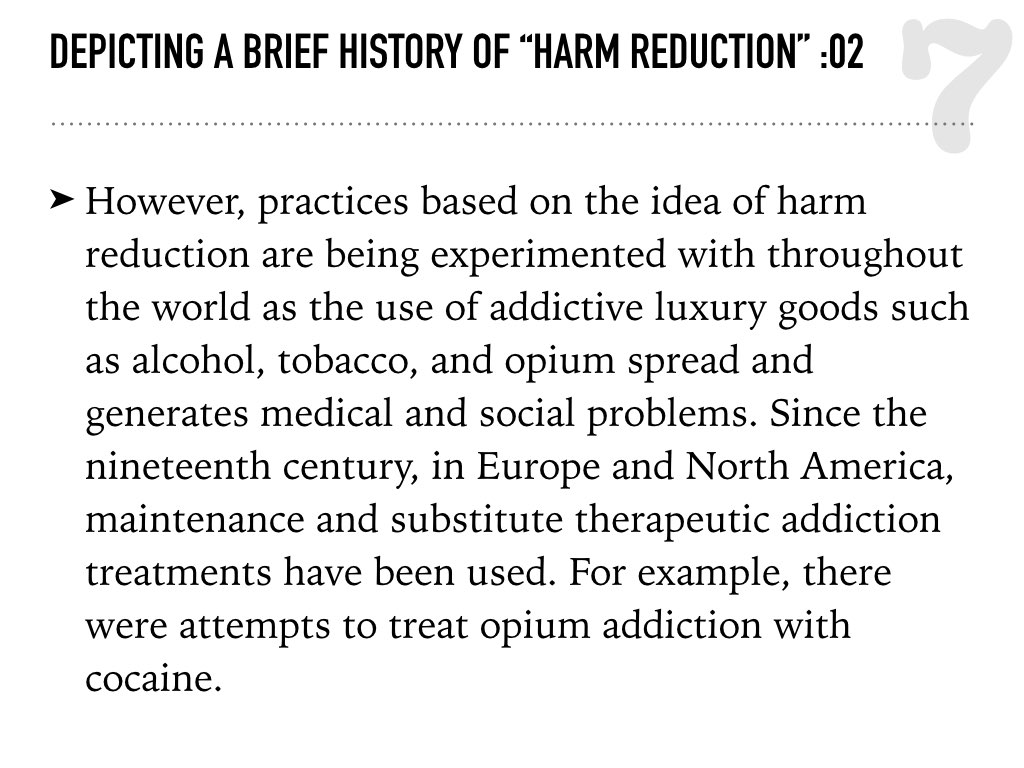 |
Depicting a brief
history of “harm reduction” :02 ->However, practices based on the idea of harm reduction are being experimented with throughout the world as the use of addictive luxury goods such as alcohol, tobacco, and opium spread and generates medical and social problems. Since the nineteenth century, in Europe and North America, maintenance and substitute therapeutic addiction treatments have been used. For example, there were attempts to treat opium addiction with cocaine. |
 |
Depicting a brief
history of “harm reduction” :03 ->In Japan’s case, in prewar Taiwan, it is known that the opium restriction policy was carried out, with its main content being the control of the opium monopoly system, the registration license system of opium uses, and the supply and taxable amounts of opium. This wiped out the number of opium users by 1945, which had made up as much as 10% of the Taiwanese population. |
 |
The Arrival of the
Term “Harm Reduction” to JapaN:01 ->In 1983 the Ministry of Health’s AIDS Research Group was established and in 1984, the AIDS Survey Committee was established. In 1987, the first AIDS Countermeasure Ministerial Conference was held. At that time, several HIV-related papers had been translated from English into Japanese. The term “harm reduction” was yet to appear among this literature; however, descriptions of trial practices such as needle exchange programs were also appearing. At that time, needle exchange programs had already achieved successful results as an HIV countermeasure in some cities in Europe and North America; however, it was closer to 1990 when the term “harm reduction” appeared in the methodology sections and the term was defined. |
 |
The Arrival of the
Term “Harm Reduction” to JapaN:02 ->In English literature from that time period, the term “harm minimization” was also often used. At this time, when initial information was being collected about HIV through overseas surveys and literature, the term “harm reduction” came to be known among some Japanese experts as an example of various HIV prevention programs for drug users. In 1994, Japan held the 10th National AIDS Conference. To participate in the conference, parties involved in harm reduction program implementation, advocacy, and research came to Japan and brought a lot of information. |
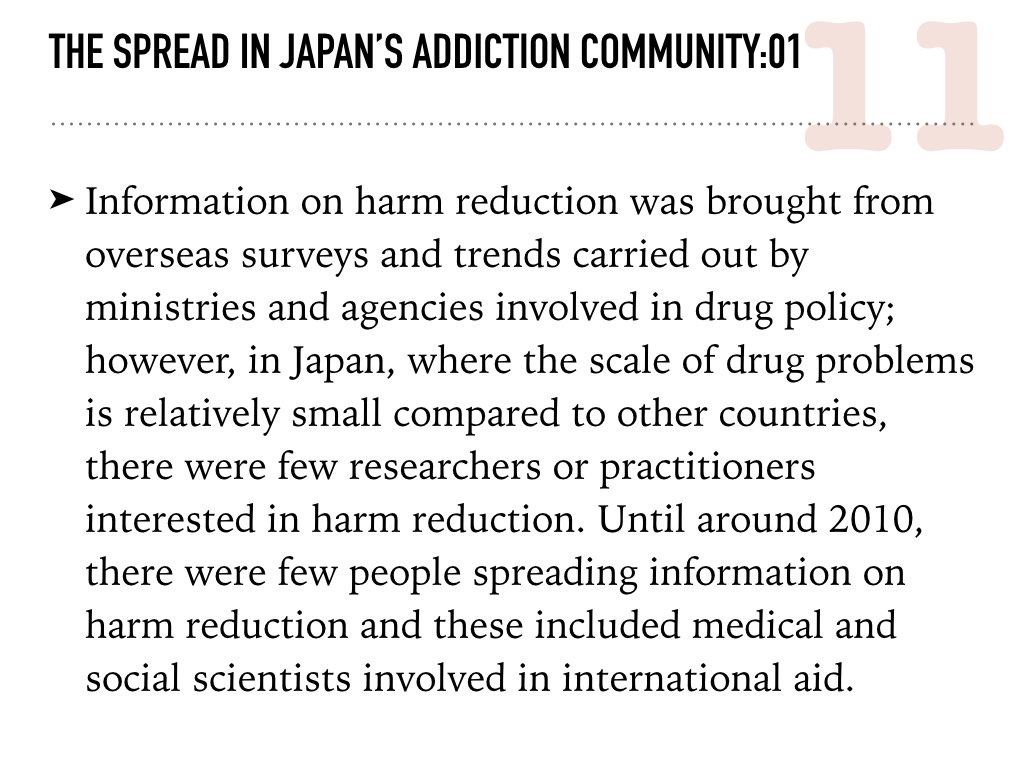 |
The Spread in
Japan’s Addiction Community:01 ->Information on harm reduction was brought from overseas surveys and trends carried out by ministries and agencies involved in drug policy; however, in Japan, where the scale of drug problems is relatively small compared to other countries, there were few researchers or practitioners interested in harm reduction. Until around 2010, there were few people spreading information on harm reduction and these included medical and social scientists involved in international aid. |
 |
The Spread in Japan’s Addiction Community:02 ->However, in the field of alcohol treatment, discussions began to take place about the effect of starting therapy goals with temperance (controlling the amount of alcohol) rather than abstinence, and the term “harm reduction” began to be used. Harm reduction became recognized in literature around 2010 as a movement to examine in conjunction with the status of Japan’s drug policy. In 2016, HR was made the theme of a specialized academic conference on addiction and discussions were held on HR practices in Japan’s alcohol and drug treatments. |
 |
STUDY B Variation of discourse on “harm reduction” in Japan |
 |
Variation of
discourse on “harm reduction” in Japan ->We conducted a qualitative research (semi-structured interview) targeted to two groups. Group One is the service users of drug addiction health care and social services including drug users and ex-drug users. Group Two is the service providers of these services (health care workers, nurses, psychiatrists etc.). For each group, 10 to 12 respondents were recruited by snow balling method. The data was anonymized and transcribed. The method of content analysis was applied to the text data in order to describe the variation of discourse regarding drug use, health care and harm reduction. |
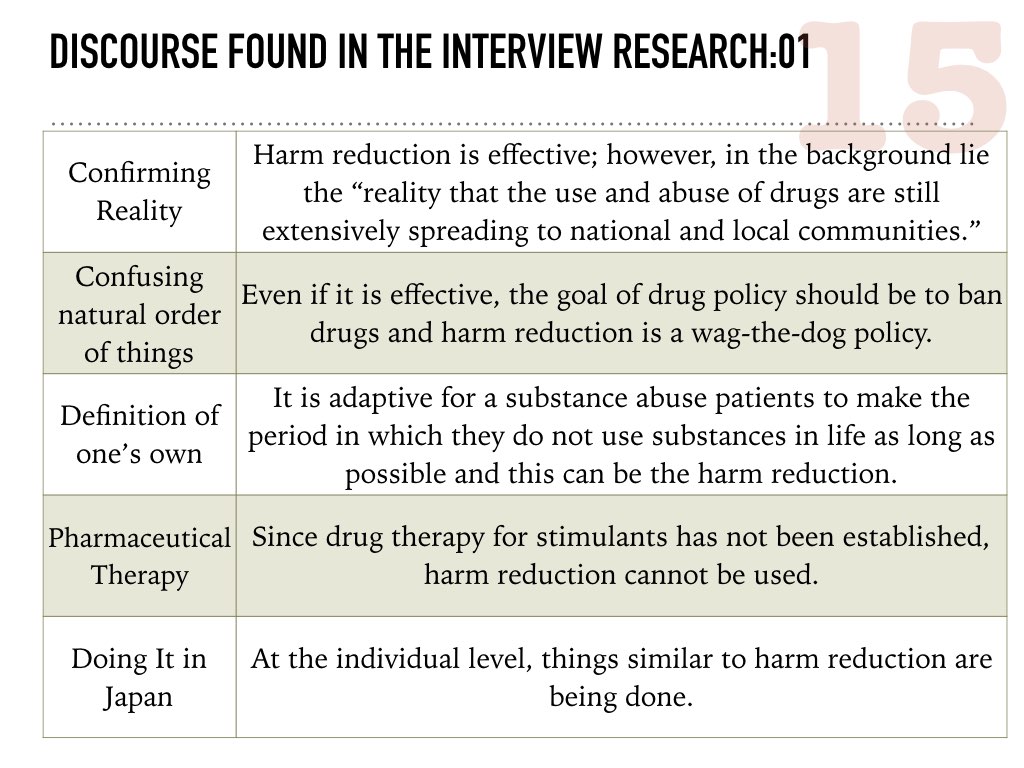 |
Discourse
found in the interview research:01 -Confirming Realit Harm reduction is effective; however, in the background lie the “reality that the use and abuse of drugs are still extensively spreading to national and local communities.” -Confusing natural order of things Even if it is effective, the goal of drug policy should be to ban drugs and harm reduction is a wag-the-dog policy. - Definition of one’s own It is adaptive for a substance abuse patients to make the period in which they do not use substances in life as long as possible and this can be the harm reduction. - Pharmaceutical Therapy Since drug therapy for stimulants has not been established, harm reduction cannot be used. - Doing It in Japan At the individual level, things similar to harm reduction are being done. |
 |
Discourse found in
the interview research:02 - Acceptance of Those Who Relaps It is important to be able to talk about relapse. There is not much meaning in blaming relapse. - Diversity Harm reduction leads to the idea that “there should be an individual recovery view.” - Things More Important If it is needed to live, then it is okay to use. Safety is necessary prior to drug withdrawal. - Avoidance of Isolation and Connection Harm reduction connects one to peers and others. - Human Rights/Humanism Harm reduction is connected to one’s natural rights as a human being. |
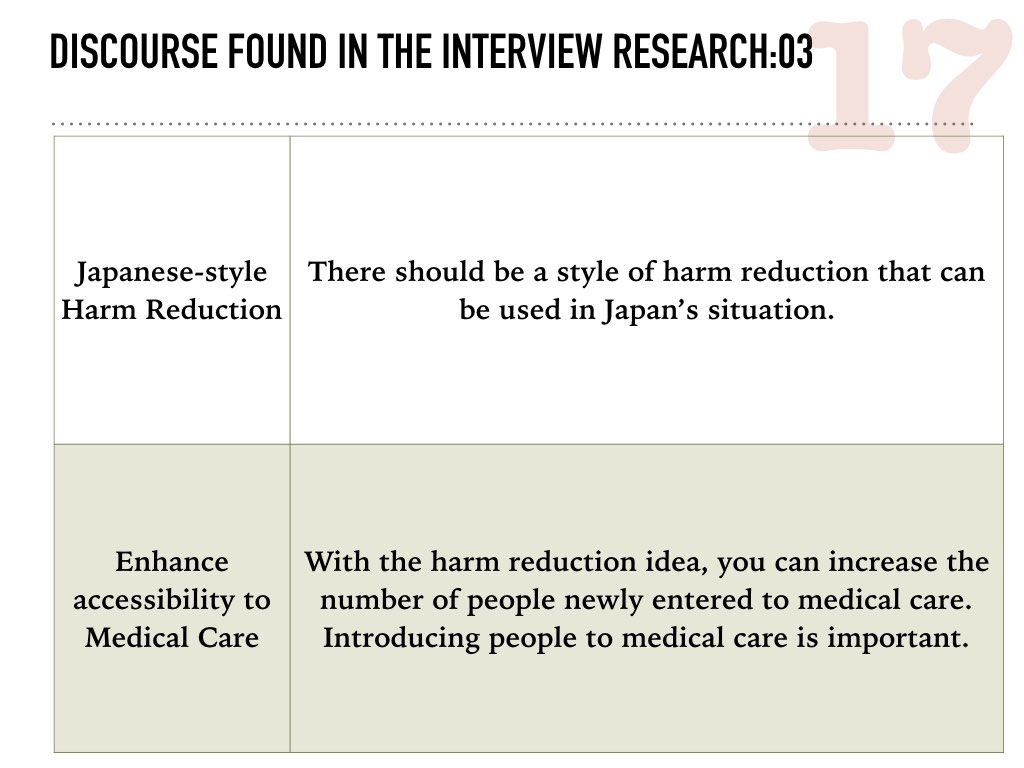 |
Discourse found in
the interview research:03 - Japanese-style Harm Reduction There should be a style of harm reduction that can be used in Japan’s situation - Enhance accessibility to Medical Care With the harm reduction idea, you can increase the number of people newly entered to medical care. Introducing people to medical care is important. |
 |
General
Description: Introducing “harm reduction” 1. Different jurisdictional systems, drug users and their “subcultures,” cultures of biomedicine, local biologies and also societies. 2. Attitude and Practice of Japanese “import” of Western systems - Japanization 3. Optimist’s and Pessimist’s views: both de-medicalization & de-criminalization, and more enhancement of social control. 4. How do we, medical & health sociologists, intervene into public sphere of users, professionals, and authorities concerned? |
 |
Brief History of
Introducing Harm Reduction on Books |
 |
Japanese
translation(2007) of Slaying the Dragon (1998) by William L White. A
variety of “addiction treatment trials” has been examined from the
abstinence movement, self-help groups, therapy communities, early
methadone treatments, to the current harm reduction trials. |
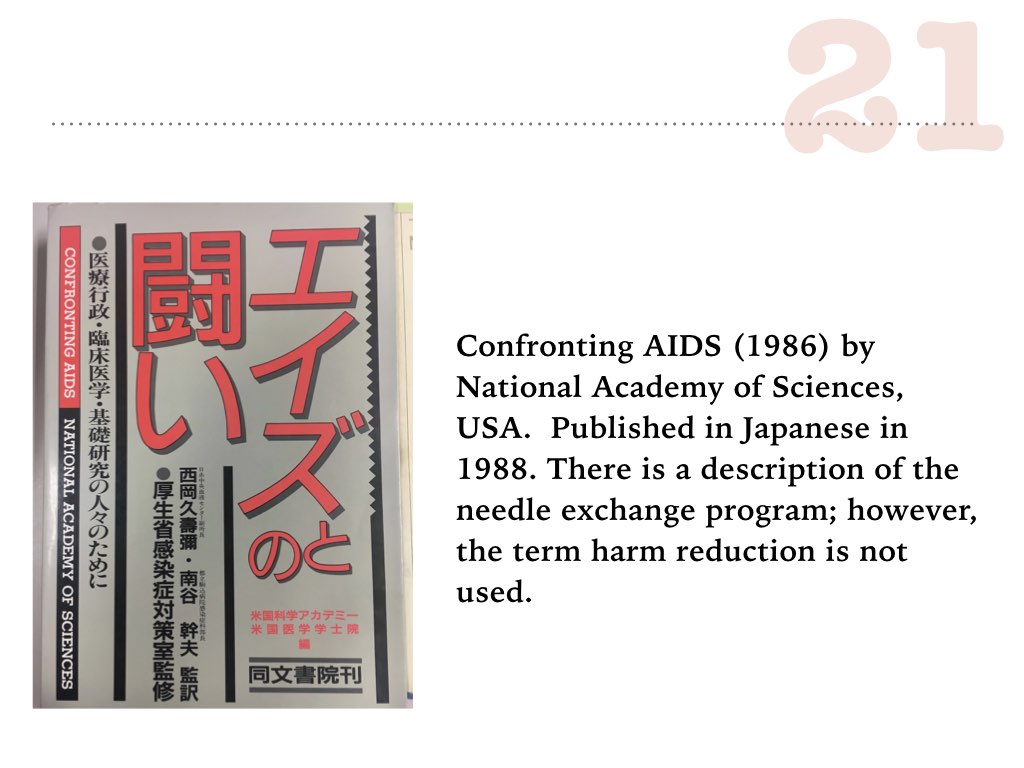 |
Confronting AIDS
(1986) by National Academy of Sciences, USA. Published in
Japanese in 1988. There is a description of the needle exchange
program; however, the term harm reduction is not used. |
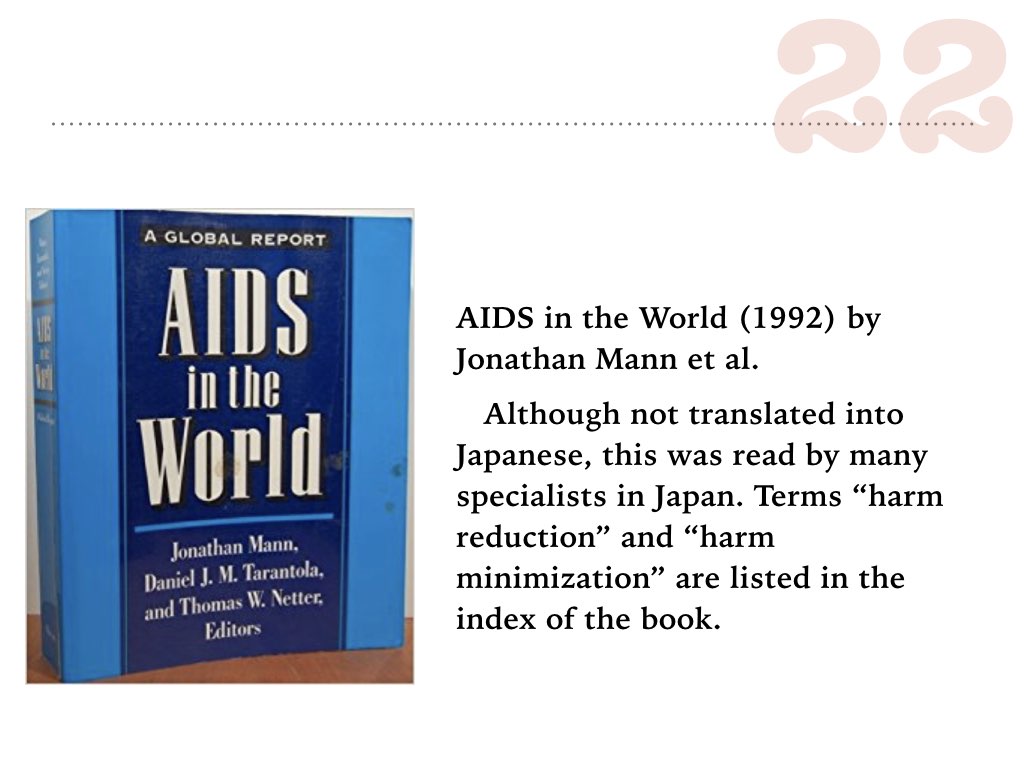 |
AIDS in the World
(1992) by Jonathan Mann et al. Although not translated into Japanese, this was read by many specialists in Japan. Terms “harm reduction” and “harm minimization” are listed in the index of the book. |
 |
Drug and
Discourse: Methamphetamine in Japan (2006) by Dr. Akihiko Sato. Author is a sociologist. There is a chapter discussing harm reduction as a measure to support European drug policy and social control mechanism |
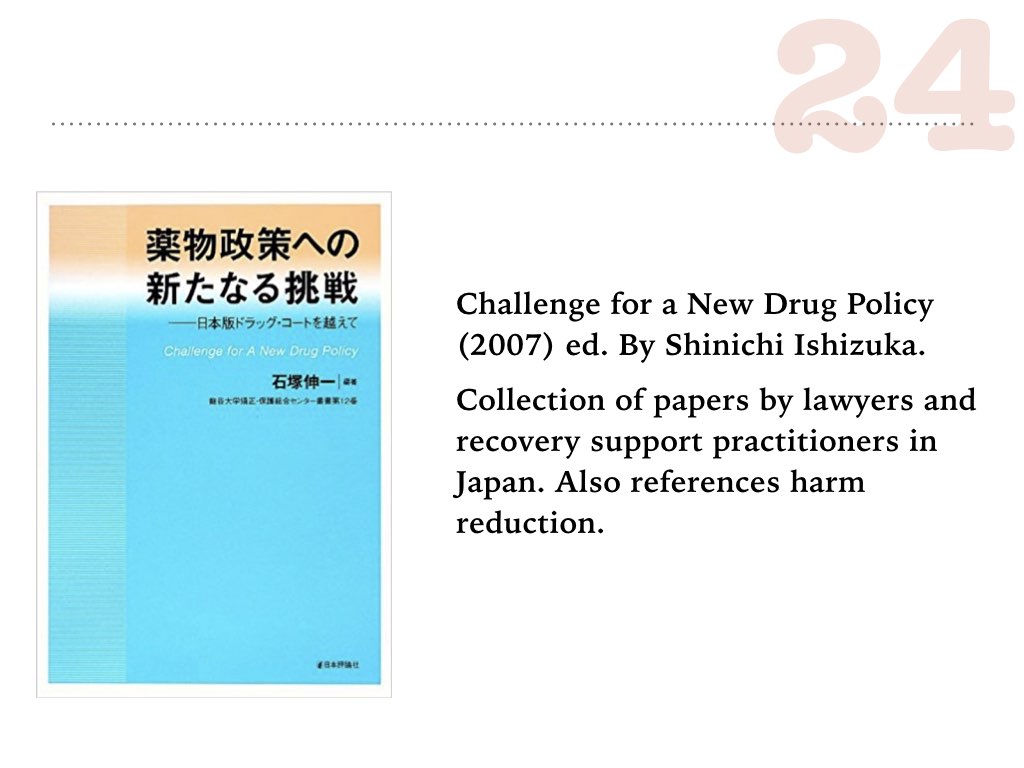 |
Challenge for a
New Drug Policy (2007) ed. By Shinichi Ishizuka. Collection of papers by lawyers and recovery support practitioners in Japan. Also references harm reduction. |
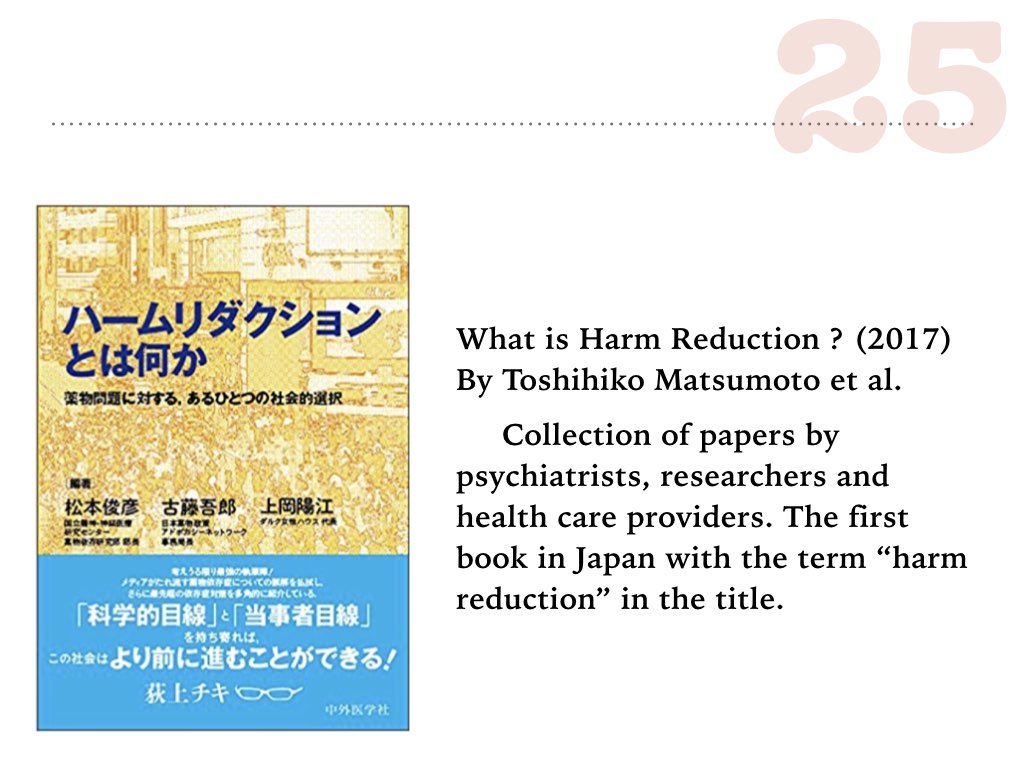 |
What is Harm
Reduction ? (2017) By Toshihiko Matsumoto et al. Collection of papers by psychiatrists, researchers and health care providers. The first book in Japan with the term “harm reduction” in the title. |
 |
From left, a book
for those who seek for dark tourism in Europe (2009), non-fiction on
the Dutch society by a journalist (1996), an area study report on the
Netherlands by academics (2006), does not use the term harm reduction,
but describes methadone buses and drug use zones. |
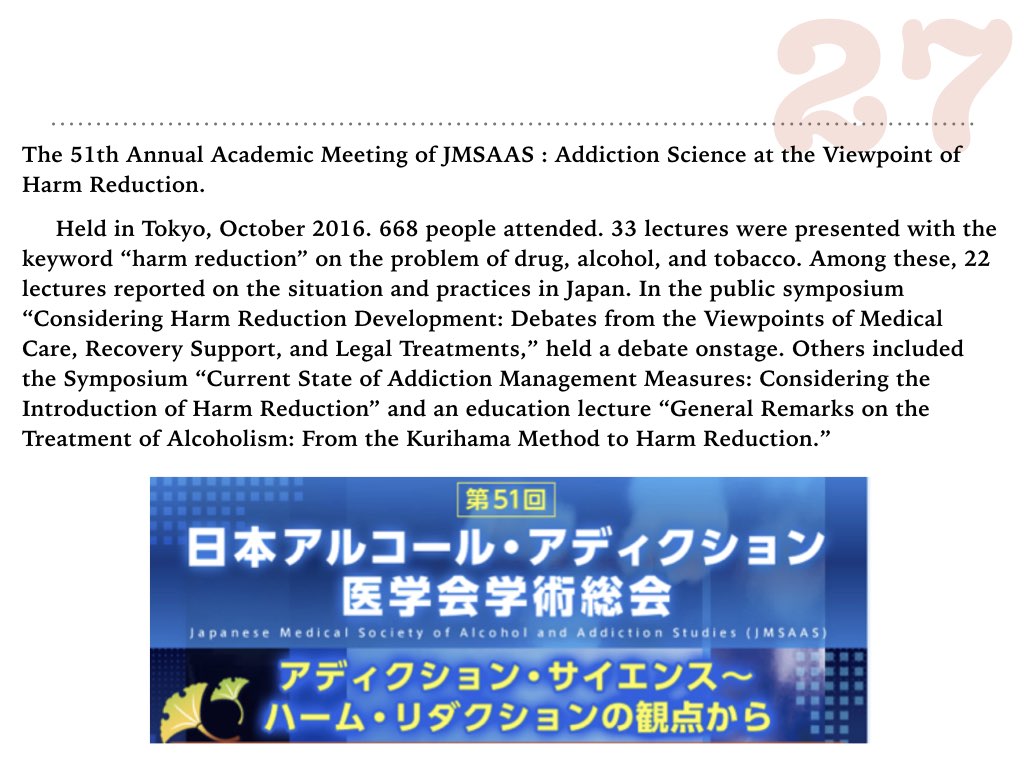 |
The 51th Annual
Academic Meeting of JMSAAS : Addiction Science at the Viewpoint of Harm
Reduction. Held in Tokyo, October 2016. 668 people attended. 33 lectures were presented with the keyword “harm reduction” on the problem of drug, alcohol, and tobacco. Among these, 22 lectures reported on the situation and practices in Japan. In the public symposium “Considering Harm Reduction Development: Debates from the Viewpoints of Medical Care, Recovery Support, and Legal Treatments,” held a debate onstage. Others included the Symposium “Current State of Addiction Management Measures: Considering the Introduction of Harm Reduction” and an education lecture “General Remarks on the Treatment of Alcoholism: From the Kurihama Method to Harm Reduction.” |
 |
Thank you for your
attention! You can access more informations about “harm reduction” by our internet resource in Japanese. For our ephemeral memory of Chet Baker, 1929-1988 |
*Credit: : On Japanization Process of Introduction to Harm Reduction Policy: From 1970s to Present, by S.Suh and M. Ikeda, 2019
* Acknowledgement, This work was supported by JSPS KAKENHI Grant Number, 18K02068
Links
Bibliography
Other informations